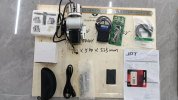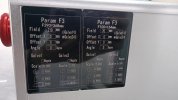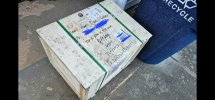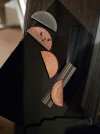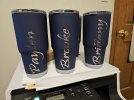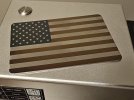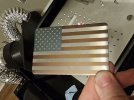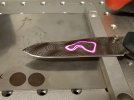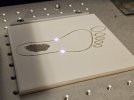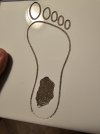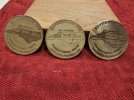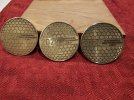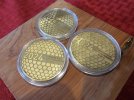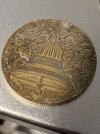In a quest to make more cool stuff, I have headed down the path of a fiber laser. I will use this to supplement my woodworking by working with challenge coins, small thin cuts for inlays, and glass and acrylic. Their capabilities are impressive!
I know lightburn from prior laser use and I wanted a fiber laser. That is the purpose for the thread. I have already purchased one, and I did a fair bit of research before doing so. I have not received it yet. You'll get the warts and all review as I set it up and learn the capabilities. My experience with fiber laswrs is generalized but there isn't a ton of good info out there.
Most common fiber lasers that people like us may be interested in are 1064nm wavelength and are good for metals, some plastics, some acrylics, glass, stone, and the like. They are emphatically NOT for wood, which has a fair to middling chance of catching fire under the influence of a fiber laser.
A fiber laser is a rather different beast from a common diode laser like you may have seen or a common CO2 laser. Most fiber lasers are "Galvo" lasers, named for their galvanometers. They use a set of mirrors to "move" the laser beam around. The working area for the sort of fiber lasers in question here is quite small, but they work extremely fast. The working area is dictated by the lens you use, with a smaller lense allowing much more power to be brought to bear.
I ordered a 70x70 and 210x210mm lens. The 70x70 will be good for challenge coins, which are something I have received a lot of requests for. The 210x210 will be used for larger sheets being cut very finely, and for modification to gun frames. They also interface with "rotary" tools that incorporate a chuck and rotating axis powered by a stepper motor to do things like engrave designs on rings, tumblers, mugs, bracelets and the like.
I did a lot of price and comparison shopping. My conclusion was unless you have Trotec or greater money (starting 11-14k) you're getting a chinese laser. Make your peace with it. And the vast majority of the lasers are assembled from relatively generic parts other than the sources (sources being the box the laser issues from), which are made most commonly by JPT and Raycus.
Searching domestic sellers led me to Monport, Omtech, and Cloudray. There are many more, but those are the heaviest advertisers at present anyway. Their prices and accessories vary wildly, even for what appears to be about the same machine. I made some inquiries that led me to a company named "Hao Tian laser", which so far as I can discern is one of the OEM suppliers. I appreciated that their sales team was zero pressure, very helpful, and answered my questions. They spoke good English as well. Most other Chinese resellers of goods are pushy and annoying.
To place an order with "Hao Tian", you cannot do so from their warehouse or website directly. They use Alibaba (not aliexpress). When I decided on my desired machine (a 60 watt mopa laser by JPT, my lenses, my rotary, and some stencils for gun frames they threw in) they drew me up an invoice I paid through Alibaba. I also paid that through PayPal and used a credit card, so while I ate a CC processing fee, I am protected at multiple levels. My total cost including the CC fee was right at $4500.
I did find a coupon code on a website shortly after the fact and emailed them asking if I could use it (as when using invoices in alibaba it does not have a coupon window). They promptly paypalled me $100 back directly, which was pretty solid customer service. (Importation) taxes are included as well as shipping.
That is where I currently am. The order was placed on 10/30, and Alibaba claims it should be "dispatched" in 20 days. Most others I've spoken to state they got theirs in about 2 weeks, and the units are generally assembled at the time of the order.
I will update this on receipt and assembly and while I'm working on one or my rooms for this to go in you might be witness to a very stupid man operating an expensive laser on top of his ping pong table in the basement.
If anyone else has any experience with fiber lasers of this sort I'd be interested in hearing about it.
Personally I am just happy I will no longer need to strap guns to my cnc table to do my NFA engravings with a drag bit anymore!
ETA: updated 11/2 to note that my laser has already shipped. Hao Tian sent me pictures of the exact unit along with the calibrations for the individual lenses as well as my name on the label when they shipped.
I know lightburn from prior laser use and I wanted a fiber laser. That is the purpose for the thread. I have already purchased one, and I did a fair bit of research before doing so. I have not received it yet. You'll get the warts and all review as I set it up and learn the capabilities. My experience with fiber laswrs is generalized but there isn't a ton of good info out there.
Most common fiber lasers that people like us may be interested in are 1064nm wavelength and are good for metals, some plastics, some acrylics, glass, stone, and the like. They are emphatically NOT for wood, which has a fair to middling chance of catching fire under the influence of a fiber laser.
A fiber laser is a rather different beast from a common diode laser like you may have seen or a common CO2 laser. Most fiber lasers are "Galvo" lasers, named for their galvanometers. They use a set of mirrors to "move" the laser beam around. The working area for the sort of fiber lasers in question here is quite small, but they work extremely fast. The working area is dictated by the lens you use, with a smaller lense allowing much more power to be brought to bear.
I ordered a 70x70 and 210x210mm lens. The 70x70 will be good for challenge coins, which are something I have received a lot of requests for. The 210x210 will be used for larger sheets being cut very finely, and for modification to gun frames. They also interface with "rotary" tools that incorporate a chuck and rotating axis powered by a stepper motor to do things like engrave designs on rings, tumblers, mugs, bracelets and the like.
I did a lot of price and comparison shopping. My conclusion was unless you have Trotec or greater money (starting 11-14k) you're getting a chinese laser. Make your peace with it. And the vast majority of the lasers are assembled from relatively generic parts other than the sources (sources being the box the laser issues from), which are made most commonly by JPT and Raycus.
Searching domestic sellers led me to Monport, Omtech, and Cloudray. There are many more, but those are the heaviest advertisers at present anyway. Their prices and accessories vary wildly, even for what appears to be about the same machine. I made some inquiries that led me to a company named "Hao Tian laser", which so far as I can discern is one of the OEM suppliers. I appreciated that their sales team was zero pressure, very helpful, and answered my questions. They spoke good English as well. Most other Chinese resellers of goods are pushy and annoying.
To place an order with "Hao Tian", you cannot do so from their warehouse or website directly. They use Alibaba (not aliexpress). When I decided on my desired machine (a 60 watt mopa laser by JPT, my lenses, my rotary, and some stencils for gun frames they threw in) they drew me up an invoice I paid through Alibaba. I also paid that through PayPal and used a credit card, so while I ate a CC processing fee, I am protected at multiple levels. My total cost including the CC fee was right at $4500.
I did find a coupon code on a website shortly after the fact and emailed them asking if I could use it (as when using invoices in alibaba it does not have a coupon window). They promptly paypalled me $100 back directly, which was pretty solid customer service. (Importation) taxes are included as well as shipping.
That is where I currently am. The order was placed on 10/30, and Alibaba claims it should be "dispatched" in 20 days. Most others I've spoken to state they got theirs in about 2 weeks, and the units are generally assembled at the time of the order.
I will update this on receipt and assembly and while I'm working on one or my rooms for this to go in you might be witness to a very stupid man operating an expensive laser on top of his ping pong table in the basement.
If anyone else has any experience with fiber lasers of this sort I'd be interested in hearing about it.
Personally I am just happy I will no longer need to strap guns to my cnc table to do my NFA engravings with a drag bit anymore!
ETA: updated 11/2 to note that my laser has already shipped. Hao Tian sent me pictures of the exact unit along with the calibrations for the individual lenses as well as my name on the label when they shipped.
Attachments
Last edited:

